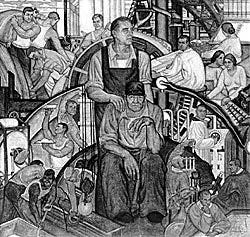The rise of the New Deal and the decline of Jim Crow
Historian Jason Morgan Ward on Georgia Governor Eugene Talmadge's response to the New Deal
NOTE: Today’s post isn’t about what was going on in schools back in the day. At least, not directly. As a reminder, occasionally, in this space, I’ll write about the bigger social, political, and economic histories that shaped yesterday’s classrooms. Today is one of those days.
In Defending White Democracy: The Making of a Segregationist Movement and the Remaking of Racial Politics, 1936-1965, historian Jason Morgan Ward examined the politics of southern segregation. According to Ward, a white backlash against Black civil rights had been building since the 1930s and can be traced to a slowly unfolding southern reaction against the New Deal.

Take Georgia for example…
In the early 1930s, most (if not all) of Georgia’s political leaders supported President Roosevelt and his New Deal programming. But, by the mid 1930s, Governor Eugene Talmadge had turned against the president by attacking the New Deal. Ward described Talmadge’s actions this way:
When he lashed out at the president and his Georgia allies with provocative racial warnings, Talmadge connected the rise of the New Deal to the decline of Jim Crow. While few prominent southern politicians were ready to take that leap with him, Talmadge and other militant white supremacists foreshadowed a broader confrontation between southern racial conservatives and the national Democratic Party.
After Roosevelt won re-election in 1936, this broader confrontation picked up steam. Ward argued that:
Serious devision arose among white southerners over the New Deal and its implications for the region. The scattered racial confrontations of the New Deal years convinced more than a few white southerns that they would have to fight to maintain their racially exclusive brand of democracy.
And in the case of Georgia’s governor and his supporters:
Talmadge allies charged early and often that the New Deal imported “social equality” to Georgia… [and thus] white supremacy’s survival, Talmadge warned, was at stake.
In other words, some southern segregationists viewed Roosevelt’s New Deal coalition as a threat to the white supremacist hierarchy of the American South. White political elites like Talmadge benefited from the racial wedge segregation created between lower class whites and the Black population—a wedge that was threatened by the economic and social supports offered by the New Deal.
So, according to Ward’s analysis, the South’s massive resistance to Black advancement didn’t just spring up overnight in response to the Supreme Court’s ruling against school segregation in Brown v. Board of Education in 1954 (as it’s often argued). Rather, it was rooted in a 1930s movement to support what Ward calls white democracy.
This white backlash against Black threats to white democracy came to a head in the 1960s—especially with the passage of the Civil Rights Act of 1964. But that’s a story for a different post on a different day.
More to come soon…
Secondary Sources
Ward, Jason Morgan. Defending white democracy: The making of a segregationist movement and the remaking of racial politics, 1936-1965. Chapel Hill, NC: The University of North Carolina Press, 2011.

